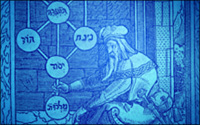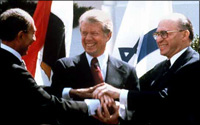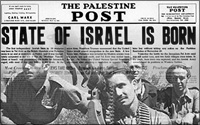 The Jewish world would change irrevocably in the 1600s. It was a time of even-greater-than-usual turmoil in Jewish life, reaching its nadir in the calamity of the false messiah, Shabbatai Zvi. The foundation for those calamitous times was laid in the historic events that took place a century earlier in the 1500s – particularly through the spread of Kabbalah.
The Jewish world would change irrevocably in the 1600s. It was a time of even-greater-than-usual turmoil in Jewish life, reaching its nadir in the calamity of the false messiah, Shabbatai Zvi. The foundation for those calamitous times was laid in the historic events that took place a century earlier in the 1500s – particularly through the spread of Kabbalah.
As rational and understandable as the tenets of Judaism are, ultimate understanding of it lies beyond the realm of the intellect. Therefore, there was always a strain of mysticism within Judaism. However, for centuries its study rested only among select scholars in an unobtrusive, almost invisible fashion. This anonymity ceased in the 16th century. Then, the ideas of Kabbalah became not only well-known, but dominant in Jewish thought — and they continue to hold prominence today.
The epicenter of this change was the city of Safed. In the mid-1500s it was home to the highest concentration of holy and unique scholars perhaps in the history of the Jewish people since the destruction of the Temple. As mentioned previously, Rabbi Joseph Caro flourished there and authored the Shulchan Aruch, which is a practical guide to Jewish law and life. At the same time, there lived in the Safed arguably the greatest mystic in Jewish history, at least in terms of disseminating original thoughts on the nature of existence and spreading the Kabbalah throughout the Jewish world. His name was Rabbi Isaac Luria, known as the “Ari” (Lion).
Although he died young, and only taught his ideas to a small circle of scholars for a little more than two years, his contribution to Jewish history cannot be underestimated.
The Ari had two types of disciples. His main student, Rabbi Chaim Vital, attempted to keep his teacher’s works secret or within the circle of students and colleagues; not to publicize it. Rabbi Vital, who lived a long life, wrote all his teacher’s notes and annotated them — but he did not publicize them. He held that the world was not ready for them, and premature exposure would be counter-productive.
However, the other younger colleagues of the Ari did spread it. Within 30 years of the Ari’s death, his works became well known throughout the Jewish world. They reached Eastern Europe[1] almost at the same time that the Sephardim were studying them in North Africa and Iraq.
Yet, even as the ideas of Kabbalah came east and captured the minds and hearts of Jewish scholars, the Jews in Eastern Europe were still less Kabbalah-oriented than the Sephardic Jews. Therefore, it will not be an accident that the debacle of Shabbatai Tzvi, the false messiah, was centered in the Mediterranean Basin, not Eastern Europe. The reason is because the Kabbalah prepared the ground for messianism. In Eastern Europe, as important as Kabbalah was it was still secondary to the study of the Talmud and Jewish law. That remained primary; the Kabbalah was secondary.
Faith and Skepticism
Simultaneously as the Ari’s Kabbalah was being developed and spread, there appeared for the first time books of Jewish history. Sometimes they were memoirs of a person who felt his world was going to be destroyed and he wanted to leave over a remembrance. Other books were almost intended to be competitors of the non-Jewish books of the time to show that the Jews also had a history with their own story to tell in their own way.
One example is a book called Shevet Yehudah, the “Staff of Judah,” which was a collaborative effort of three brothers from a famous family of Spanish origin called Verga. Another history book is Shalsheles HaKabbalah by Gedaliah Ibn Yahya. Yet, among this new genre of Jewish history books, none was as controversial and shrouded in mystery as the three-volume Me’or Enayim (“Light of the Eyes”).
Written by Rabbi Azariah dei Rossi (1514-1578) it was published in the 1500s and republished many times since then. It is a critical history of the Jewish people and caused a great stir. It was even banned a couple of times. It is a classic product of the Renaissance, written with a biting skepticism, unwilling to accept legend and mythology, attempting to “scientifically” determine the dates and ways of how things happened.
The book itself is guilty of many of the inaccuracies it projects upon others. The author’s motivations are also not clear. His enemies portrayed him in a very black light. Nevertheless, the book is quoted by famous Jews of later centuries.
The skepticism evident in dei Rossi’s Me’or Enayim is reflective of the new spirit of the times that crept into Jewish life in general even as Jewish mysticism exploded in popularity. On one hand, it was a time of dissemination of Kabbalah and belief in miracles. On the other hand, a broad-based critical-skeptical view of life made its appearance. Both viewpoints were expressed by people who claimed to be believing Jews pursuing the truth. This clash will become sharpened and heightened in the next 200 years and also serve as the basis of a great division within the Jewish people.
Expansion and Repression in Poland
Despite the widespread impression that Poland was a place of poverty and misery for Jews, there was a time starting in 16th century when Jews flourished there. They built great communities with renowned Torah academies. It was a golden age for Polish Jewry.
The great Polish rabbis of this time include Rabbi Moses Isserles in Krakow, Rabbi Solomon Luria in Lublin and others. These scholar-leaders set the foundation for Polish Jewry. One is hard-pressed to find another place in the diaspora that boasted the talent, creativity and liveliness that Polish Jewry had at this time.
The Jews, in fact, became so strong in Poland that it eventually caught the attention of and raised the enmity of the Roman Catholic Church. More than the government, the Church was the main opposition to Jewish life in Poland. It was compounded by the fact that a number of Polish noblemen converted to Judaism. All of them were burned at the stake by the Church. The Jews were perceived as a great threat by Christian clergy, and this enmity even continued all the way into the Second World War.
The Church also was very frightened that the Protestant Reformation would reach Poland. Therefore, it was very active making certain that Poland remained a steadfast and staunchly Roman Catholic country. Part of that campaign to hold off the Protestants was to curtail Jewish influence, if not uproot and crush the Jews entirely.
Therefore, even though 16th century marks the beginnings of a great Jewish community, it also marks the beginnings of a particularly heavy hand of the Church against the Jews.
New Persecutions
Jewish persecution by the Church was not limited to Poland. At the turn of the 17th century there began organized persecution of the Jews in Central Europe, e.g. Bohemia, parts of Austria, part of what is today the Czech Republic, etc. The Jews underwent terrible privations and many were driven from their communities.
These persecutions were no longer just politically or materially motivated. They took on now more and more of a religious nature. Luther via the Protestant Reformation had reawakened all of the religious problems of Europe. For a long time Jews were viewed as nothing more than deviants. They were not liked, but there was nothing much to do about them, and they were more or less tolerated.
Now, as the Protestants and Catholics struggled with each other and accused everyone else of being heretics, the society was less accepting of deviants. In order to exist, one had to prove his right to exist. And Jews could not prove that right to the Christian world.
Therefore, Jewish communities in Central Europe that had existed for long periods of time came to an end. This is one of the factors that contributed to ascendancy of Eastern European Jewry.
England and Amsterdam
In England at this time the Puritans gained control. Strict and literalistic, they had taught themselves Hebrew so that they could read the Bible in its original language. They even gave their children Hebrew names.
The Puritans, of course, would become the founders of America. If one looks at the names on the Mayflower Compact one will see that almost all 200 names there are biblical. There was even a vote taken whether the spoken language in the New World should be Hebrew or English. Many felt that since it was a type of entry into the “Promised Land” for them they wanted to speak the “Holy Tongue.”
This is why some of the oldest institutions of higher education in the United States have seals or mottos with Hebrew. Even though the Puritans were far from being lovers of the Jews, the fact that they had an affinity for Hebrew and the Bible allowed them to think on some level about religious freedoms for Jews. Later when the early settlers provided rules for religious freedom they included the Jews, even though there were so few Jews to avail themselves of those opportunities. Nevertheless, the United States was really the first country in the world that had rules where religious discrimination against Jews was not sanctioned.
On the other hand, the English Protestants under Oliver Cromwell expelled the Jews from England and confiscated all of their books. The Jews were again forced to flee. Most of them fled across the Channel to the Jewish community of Amsterdam.
In Amsterdam at this time (the early 1600s) there lived a brilliant and dynamic rabbi, Menasseh ben Israel. We have portraits of him by famous Dutch artists. He was so well-known and well-respected that he was able to get an audience with Cromwell and convince him to allow the Jews to return to England.
The Jews in Amsterdam were instrumental in developing the city, including its renowned channels and port. It became a center of international trade. Jews were also very active in the Dutch East India Company which commissioned many expeditions such as the ones that helped develop America in colonial times.
In short, and for a period of time, Jewish Amsterdam became a capital of Jewish life. This would enable it to play a central role in the pivotal events of the 17th century.











